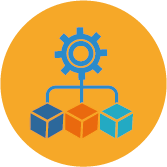By Philippe Magne
With the major economic crisis we are all facing together, it is high time to take a fresh look at our existing application assets.
Many companies are still convinced that they have to replace their legacy platform, along with all the applications running on it. Most business leaders have at some point dreamt of having a cutting-edge information system, driving their company’s performance and always flexible to their changing business needs. Many of these companies blessed with the financial means to do so have embarked on reengineering or replacement projects of titanic proportions. Some of them – after taking their organization through deep and costly transformations and consuming considerable resources over the years – have finally succeeded in ‘crossing the Rubicon’. The vast majority however have decided to stop and reconsider, realizing that the original investment required has been largely underestimated and that if they continue on the same course they could risk putting their entire business in jeopardy.
With a potential economic crisis looming, these massive “works in progress” will inevitably be put under some scrutiny. Would it not make better business sense to reinvest in existing assets rather than replace everything? And most importantly, to consider options which lessen the risk involved? In these uncertain times, it is important to question whether a replacement is really essential – but before feeling comfortable with what on face value may seem like a strategic U-turn, we need to look inwards and ask ourselves a different question. Why were we so sure in the first place that everything needed to be replaced ? Apart from the fact that our ecosystem naturally leads us to over-consume, it is clear that most of the time, the decision to replace a system is based on a relatively cursory assessment and a number of “myths” or preconceived ideas. As soon as we accept that these are the main cause of our strategic misdirection, we can put our emotions to one side and take a critical look at each of these ideas.
In this article we will examine the ten most common preconceptions about legacy systems.
Summary
- “Legacy systems can’t adapt to digital transformation”.
- “The continuity of legacy systems is not ensured by the manufacturer.”
- “The TCO (Total Cost of Ownership) of legacy systems is very high”.
- “Legacy systems are not compatible with the Cloud.”
- “Skilled resources have become very scarce.”
- “The younger generations are put off by these systems.”
- “It is impossible to convert existing teams to the new ways of working”.
- “The monolithic architecture of legacy applications is an obstacle to their evolution”.
- “No one dares touch these ‘huge monoliths’ of 20-30,000 lines of code”.
- “Legacy applications no longer meet the needs of users”.
1. “Legacy systems can’t adapt to digital transformation”.
False. This would have been true if these systems had not evolved, if they had remained locked in a closed world, cut off from the rest of the industry. Today, this is far from the case. Every day we consume services on the Web or on our smartphones that are connected to legacy systems. The most typical example for us all is our bank! Yes, as we all know it is absolutely possible to deliver a legacy system through the Cloud, and to develop web interfaces and web services for this legacy system too. From a technology standpoint these systems have become perfectly ‘normal’ and can form a natural part of your digital transformation strategy. I don’t want to dwell here on all their advantages – that would be an article in itself – but security, reliability and scalability are undeniably the key strengths of the legacy platforms. Everything possible has been done to make them ‘ordinary’ and ensure they fit naturally into the overall information system. We should be careful however not to ignore all platform specifics as it is many of these that create the business value that their customers enjoy.
2. “The continuity of legacy systems is not guaranteed by the manufacturer.”
False: Even though there is now almost only one manufacturer left in this category, IBM will not be abandoning these systems any time soon, given they run 70% of the world’s business transactions even today. New versions of the operating systems are released on average every two years, each with significant innovations and a comprehensive roadmap spanning the next twenty years.
But the most powerful argument for their sustainability is that legacy systems remain an important source of revenue for IBM. Add to this a customer base which is uniquely and unequivocally loyal to the platform. These two factors mean that we all benefit from a perfectly stable and sustainable business model.
3. “The TCO (Total Cost of Ownership) of legacy systems is very high”.
True and False: This is clearly the case in the z/OS mainframe world where customers are all trying, in one way or another, to reduce their consumption of “MIPS”. It is however totally false in the case of the IBM i (aka iSeries, AS/400) world, for two main reasons:
– The first is that IBM i applications have been running on “Power” machines for over 25 years, the same machines that also host Unix (AIX) and Linux applications. IBM i customers have therefore been reaping the benefits of economies of scale for a long time now. The acquisition cost is identical for each of these three operating systems.
– The second is that, thanks to its unique architecture which combines both the O/S and database manager in a fully integrated way, administration of the IBM i platform is almost child’s play. I used to call it “the operating system for dummies”, pardon me. In some SMEs, we sometimes find the accounting department doubling up as system administrator…
4. “Legacy systems are not compatible with the Cloud.”
False: You could have that impression because up until last year, there was no Public Cloud offering available – only classic hosting was on offer.
But fast forward to today, three companies are offering Cloud with a per-hour rate such as AWS, Azure or others: Skytap, IBM and even Google.
– The movement towards the Cloud will continue to be massive in the months and years to come. There is no reason why corporations using legacy systems should not profit from and embrace this trend.
5. “Skilled resources have become very scarce.”
True and False: It is true that experienced resources are becoming increasingly scarce on the market. As the retirement curve continues to rise, this challenge will not lessen over time. But here we have the best example of one of the hard-nosed preconceived ideas that can cause management to “throw it all away”. It is based on two simple misconceptions:
1- It is impossible to train young developers in these systems,
2- Existing teams have no desire to change the way they work.
These two points are dealt with below. In essence, what we can say is that many large companies have already made the decision to continue investing in their legacy platforms, a trend that will inevitably reverse the entire situation in the years to come. This is the catalyst that will resolve the scarcity of skilled resources through market forces alone.
6. “The younger generations are put off by these systems.”
False: That is a definite preconception. Anyone who has tried introducing young people to legacy platforms will testify to the contrary. They are far from put off and indeed rather positive about the platforms. On the other hand, many of them are highly skilled in new development techniques. This is one of the key reasons that the DevOps movement is so strategic. For a young developer, switching between COBOL, RPG, Java, Python, .Net is trivial. Modern developers move easily from one language to another. However, the development environment itself is highly important. It must be based on tools that the developer is already familiar with, such as Git for managing source code. To maximize the value of this new talent the new breed of tools must be both modern and agile so that the developer can produce high quality code quickly with as few constraints as possible.
7. “It is impossible to convert existing teams to the new ways of working”.
False. This can be difficult and time-consuming, but not impossible. You may even be pleasantly surprised. What most companies have done is to start out by excluding their legacy teams from all the major advances they were making in terms of digital transformation. To be fair many already had a huge backlog of work on their hands and the legacy systems were considered ‘stabilized’ and in many cases already ‘automated’ to a great extent. This disparity caused frustration and led to a ‘silo’ effect between teams, definitely not conducive to company efficiency overall. Nowadays however, the legacy side of the business is systematically included in any strategic decision making process, whether that be about infrastructure, architecture, tools or security. Legacy is no longer the “poor relation” of any corporate IT strategy change.
8. “The monolithic architecture of legacy applications is an obstacle to their evolution”.
True. Imagine a dish of spaghetti, when you pull one piece, everything comes with it. We now know that for code to be as maintainable as possible, it has to be as modular as possible. Yet these principles were not the norm 20 or 30 years ago. A monolithic architecture makes it very difficult to have development teams work in parallel. The only way out of this rut is to define new architecture standards and progressively transform applications. Until that time, the legacy application change rate must be kept to a minimum (if possible).
9. “No one dares touch these ‘huge monoliths’ of 20-30,000 lines of code”.
True. Given the criticality of these applications and their complexity, it is clear that when new to a company many CIOs are extremely reluctant to undertake any risky code change. The only solution is to get ‘tooled up’. Anything that facilitates the understanding of source code must be made routine. The time savings from automation are especially significant. A new and modern category of tools is becoming increaasingly valuable, that of monitoring code quality and compliance with best practices. Even more so now, since these tools go further than checking for specific errors or weaknesses in code, the new breed of source code analysis tools can deliver value around both quality and security aspects.
10. “Legacy applications no longer meet the needs of users”.
This is often true, but it is mainly due to lapses in strategic management over the years. Convinced that these systems would be rapidly retired or even wither away sooner rather than later, legacy applications were often starved of investment, to the point of near obsolescence. If these systems had received ongoing investment as before, they would now be far from obsolete! To further underline the point, those companies that did decide to functionally and technically enhance their legacy assets are in a much stronger position than others today.
Some might read into this article a none too subtle plea to keep their legacy systems at all costs, given that ARCAD Software has built its reputation on IBM i technology (or should I say here AS/400 to emphasize its legacy origins). To those I would just like to emphasize that our mission is to accompany our clients in their digital transformation and that our revenues on and off the IBM i platform are nearly equal. So our vision is not partisan, but pragmatic.

Philippe Magne
CEO, ARCAD Software
Philippe Magne is CEO and Founder of the ARCAD Software, global ISV specializing in the areas of DevOps, IBM i Modernization and Data Masking. As Quality Assurance manager at the European Space Agency, Philippe initiated the ARCAD software lifecycle management project in 1988. He then created the ARCAD Software company in 1992 to assure the development and marketing of the software. Since, he has steered the company to produce a complete and integrated range of solutions distributed by IBM worldwide. Today ARCAD Software is recognized as the worldwide leader in DevOps for IBM i. Philippe is an unceasing champion of enterprise modernization and frequent speaker at events across the world.

REQUEST A DEMO
Let’s talk about your project!
Speak with an expert


























